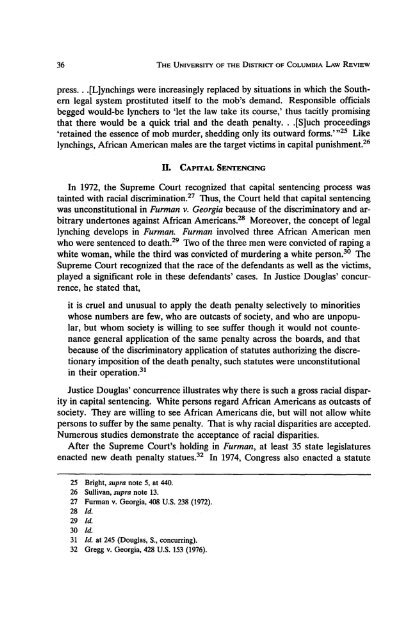The University of the District of Columbia Law ... - UDC Law Review
The University of the District of Columbia Law ... - UDC Law Review
The University of the District of Columbia Law ... - UDC Law Review
You also want an ePaper? Increase the reach of your titles
YUMPU automatically turns print PDFs into web optimized ePapers that Google loves.
36 THE UNIVERSITY OF THE DISTRIcr OF COLUMBIA LAW REVIEWpress ... [L]ynchings were increasingly replaced by situations in which <strong>the</strong> Sou<strong>the</strong>rnlegal system prostituted itself to <strong>the</strong> mob's demand. Responsible <strong>of</strong>ficialsbegged would-be lynchers to 'let <strong>the</strong> law take its course,' thus tacitly promisingthat <strong>the</strong>re would be a quick trial and <strong>the</strong> death penalty ... [S]uch proceedings'retained <strong>the</strong> essence <strong>of</strong> mob murder, shedding only its outward forms.' ,,25 Likelynchings, African American males are <strong>the</strong> target victims in capital punishment. 26U. CAPITAL SENTENCINGIn 1972, <strong>the</strong> Supreme Court recognized that capital sentencing process wastainted with racial discrimination. 27 Thus, <strong>the</strong> Court held that capital sentencingwas unconstitutional in Furman v. Georgia because <strong>of</strong> <strong>the</strong> discriminatory and arbitraryundertones against African Americans. 28 Moreover, <strong>the</strong> concept <strong>of</strong> legallynching develops in Furman. Furman involved three African American menwho were sentenced to death?9 Two <strong>of</strong> <strong>the</strong> three men were convicted <strong>of</strong> raping awhite woman, while <strong>the</strong> third was convicted <strong>of</strong> murdering a white person. 30 <strong>The</strong>Supreme Court recognized that <strong>the</strong> race <strong>of</strong> <strong>the</strong> defendants as well as <strong>the</strong> victims,played a significant role in <strong>the</strong>se defendants' cases. In Justice Douglas' concurrence,he stated that,it is cruel and unusual to apply <strong>the</strong> death penalty selectively to minoritieswhose numbers are few, who are outcasts <strong>of</strong> society, and who are unpopular,but whom society is willing to see suffer though it would not countenancegeneral application <strong>of</strong> <strong>the</strong> same penalty across <strong>the</strong> boards, and thatbecause <strong>of</strong> <strong>the</strong> discriminatory application <strong>of</strong> statutes authorizing <strong>the</strong> discretionaryimposition <strong>of</strong> <strong>the</strong> death penalty, such statutes were unconstitutionalin <strong>the</strong>ir operation. 31Justice Douglas' concurrence illustrates why <strong>the</strong>re is such a gross racial disparityin capital sentencing. White persons regard African Americans as outcasts <strong>of</strong>society. <strong>The</strong>y are willing to see African Americans die, but will not allow whitepersons to suffer by <strong>the</strong> same penalty. That is why racial disparities are accepted.Numerous studies demonstrate <strong>the</strong>· acceptance <strong>of</strong> racial disparities.After <strong>the</strong> Supreme Court's holding in Furman, at least 35 state legislaturesenacted new death penalty statues. 32 In 1974, Congress also enacted a statute25 Bright, supra note 5, at 440.26 Sullivan, supra note 13.27 Furman v. Georgia, 408 U.S. 238 (1972).28 [d.29 [d.30 [d.31 [d. at 245 (Douglas, S., concurring).32 Gregg v. Georgia, 428 U.S. 153 (1976).














